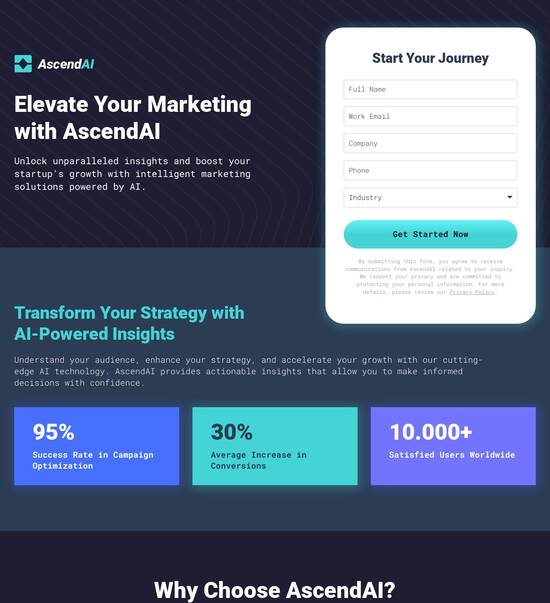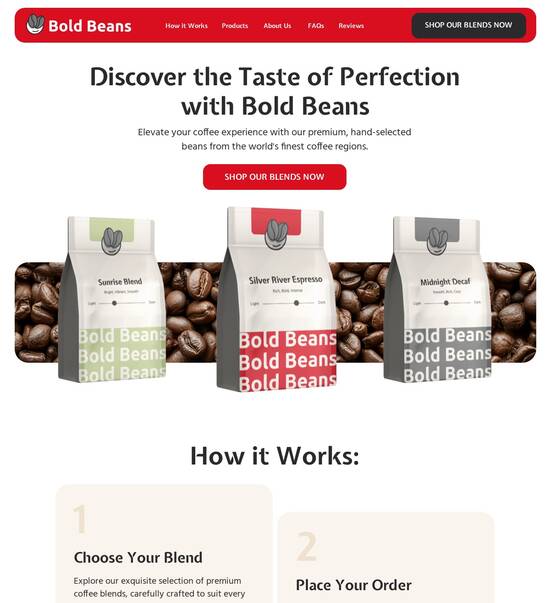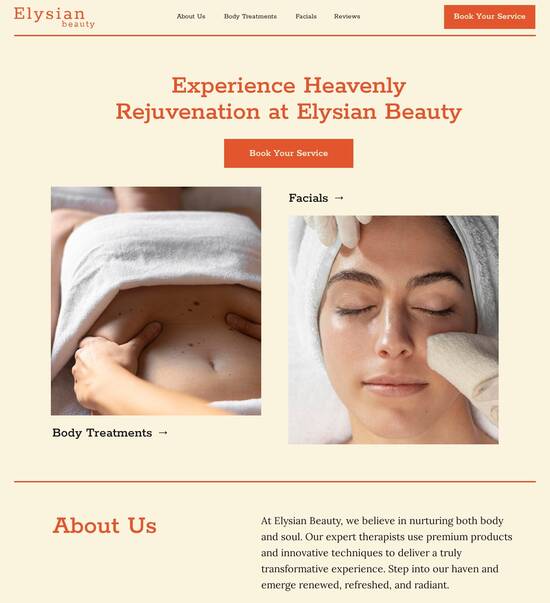
Vue.js optimized upcoming events page template
Explore Similar TemplatesAbout template
Supercharge your upcoming events page with Vue.js for outstanding performance! Learn more today.
Recommended templates

Easy to build without coding
With the intuitive drag-and-drop builder, anyone on your team can create high-converting pages without any knowledge of code or design. Make enhancements to your landing page with custom widgets using Javascript, HTML/CSS, or third-party scripts.

Multiple layouts for any industry and goal
Select from 500+ landing page layouts built to boost conversions across industry-specific scenarios. Customize them by adjusting fonts, adding images, and generating on-brand content with the AI assistant. Quickly scale with Instablocks® and Global Blocks that you can save, reuse, and update globally.

Loads fast and looks polished on any device
Every template is responsive, which means they present professionally on any device and load blazingly fast with our Thor Render Engine. You can also power them up with Google AMP technology to deliver an unparalleled mobile experience and drive higher conversions.

Robust analytics & experimentation
Get real-time updates and reporting across all your devices, showing the number of visitors, conversions, cost-per-visitor, and cost-per-lead. Launch AI-powered experiments, run A/B tests, and use heatmaps to analyze user behavior, then optimize your landing page to maximize conversions.







Easy to build without coding
With the intuitive drag-and-drop builder, anyone on your team can create high-converting pages without any knowledge of code or design. Make enhancements to your landing page with custom widgets using Javascript, HTML/CSS, or third-party scripts.
Multiple layouts for any industry and goal
Select from 500+ landing page layouts built to boost conversions across industry-specific scenarios. Customize them by adjusting fonts, adding images, and generating on-brand content with the AI assistant. Quickly scale with Instablocks® and Global Blocks that you can save, reuse, and update globally.
Loads fast and looks polished on any device
Every template is responsive, which means they present professionally on any device and load blazingly fast with our Thor Render Engine.
Robust analytics & experimentation
Get real-time updates and reporting across all your devices, showing the number of visitors, conversions, cost-per-visitor, and cost-per-lead. Launch AI-powered experiments, run A/B tests, and use heatmaps to analyze user behavior, then optimize your landing page to maximize conversions.
All the features you need to build lead-generating landing pages
Explore more featuresLearn how to build top-performing landing pages for any goal
FAQs
Leading the way in building high-performing landing pages





A comprehensive guide to using Instapage for optimizing landing pages
Instapage is the premier platform for marketers looking to enhance their digital marketing strategies through effective landing page creation and conversion rate optimization (CRO). With a variety of engaging templates and robust features, Instapage empowers users to build tailored landing pages that capture leads efficiently. This guide will walk you through a step-by-step process for leveraging Instapage's capabilities to maximize ROI from your marketing efforts.
Understanding Instapage's powerful features
Before diving into the creation process, it’s essential to grasp how the platform can transform your approach to landing pages. Instapage provides various tools designed for both seasoned marketers and newcomers alike. Its user-friendly interface ensures that anyone can create polished and conversion-centric pages without needing extensive technical skills.
- High-converting templates: Instapage offers over 100 ready-to-use designs that speed up the page creation process while ensuring optimal conversions.
- Detailed analytics dashboard: Gain insights into visitor behavior and page performance to refine your strategies continually.
- A/B testing features: Experiment with different variations of your landing pages to identify which elements yield the best results.
Step 1: Choose the right template
The first step in building a successful landing page with Instapage is selecting a template that aligns with your campaign goals. Here are essential considerations to keep in mind:
- Identify your target audience: Select a design that resonates with the demographic you aim to engage.
- Align with your campaign objectives: Ensure the template’s layout and elements support the specific action you want visitors to take.
- Leverage built-in lead generation elements: Templates come with various forms and CTA buttons already incorporated.
Step 2: Customize your landing page
Once you’ve chosen a template, customization is key to making your page stand out. Here's how to approach personalization effectively:
- Use dynamic text replacement: Tailor your messaging to match the ads that led to your landing page, improving contextual relevance.
- Incorporate multimedia elements: Use images, videos, and testimonials to build trust and convey your message powerfully.
- Optimize for mobile: Ensure your landing page is responsive and delivers a seamless experience across all devices.
Step 3: Optimize and launch
After customization, optimizing your landing page for conversions is vital. Follow these steps to enhance performance:
- Implement A/B tests: Identify the most effective headlines, images, and CTAs by testing different versions of your page.
- Analyze heatmaps and user behavior: Utilize built-in analysis tools to observe how visitors interact with your page and adjust accordingly.
- Ensure fast loading speeds: Optimize images and scripts to reduce load times, as slow pages can deter potential leads.
By following these steps, you can effectively set up and optimize landing pages within Instapage to drive better marketing results.
Ready to elevate your digital marketing game? Start using Instapage today to create stunning landing pages tailored to your audience's needs and maximize your ROI!
Crafting an optimized upcoming events page with Vue.js: A comprehensive template guide
Understanding the purpose of an upcoming events page
An upcoming events page serves as a crucial component of any digital strategy. Its primary goal is to inform and engage users by displaying information about relevant upcoming events. By creating a platform where users can discover, learn about, and register for events, organizations can significantly enhance audience engagement and drive participation.
Setting clear objectives is vital for an effective events page. Whether you aim to promote webinars, community gatherings, or educational seminars, understanding your audience's needs will shape how you present information on the page.
User expectations and behavior
Users visiting an events page typically look for specific information such as event dates, locations, and registration links. They expect intuitive navigation that allows them to find details quickly without unnecessary distractions. A well-designed events page should also emphasize aesthetics, as a visually appealing layout can enhance user experience and encourage engagement.
Leveraging Vue.js for enhanced event page experience
Vue.js, a progressive JavaScript framework, offers a powerful toolset for enhancing upcoming events pages. Its primary benefits include reactivity, a component-based architecture, and an easy learning curve for developers. By utilizing Vue.js, you can create a responsive events page that updates seamlessly as users interact with it.
In addition to Vue.js, there are essential technologies to consider. For seamless navigation, integrating Vue Router is crucial, allowing users to move effortlessly between different sections of your events page. Additionally, using Axios for API calls ensures efficient data handling, making it easier to pull in event information dynamically.
Vue Router - For managing page navigation.
Axios - For making API requests to fetch event data.
Scoped CSS or frameworks like Tailwind CSS - For styling components effectively.
Structuring your event page template
Creating a well-structured event page template is essential for user experience. Key components should include an event listings section, a detailed view for each event, a calendar integration for easy date selection, and a user-friendly registration form.
Designing child components enhances modularity and reusability. For instance, an Event Card component can summarize event details and include essential information such as date, time, and location in an engaging format. A navigation bar that categorizes events helps users find what they’re looking for without scrolling through irrelevant listings.
Event Listings Component - Displays all upcoming events.
Event Detail View - Provides in-depth information about a selected event.
Calendar Integration - Helps users navigate through event dates.
Registration Form - Simplifies sign-ups for events.
Optimizing performance of the events page
Optimizing performance is key to ensuring a swift user experience. Implementing efficient data fetching is crucial; make use of API endpoints to gather event data on demand, preventing unnecessary loading of information. For example, using Axios can help streamline data requests and allow for caching, thereby reducing the number of duplicate requests from users.
In addition to optimizing data fetching, strategies like lazy loading can dramatically enhance load times. By delaying the loading of images and non-critical content until it’s needed, you can prevent users from experiencing long waiting times. Code-splitting techniques can also be applied to allow for smaller chunks of code to load initially, keeping the first interaction swift.
Enhancing user engagement with content
User engagement can be significantly improved through rich and interactive content. Creating a Q&A section that addresses common user inquiries makes the page more informative and encourages visitors to interact more deeply with the content. This not only satisfies user curiosity but also helps reduce the load on customer service.
Compelling event descriptions play a vital role in attracting attendees. Use clear and engaging language, and highlight why the event should not be missed. Providing potential attendees with enough detail ensures they feel informed and motivated to participate.
Q&A Sections - For addressing common inquiries.
Compelling Descriptions - To entice potential attendees.
Social Sharing Buttons - To help users share events with their networks.
Mapping user interactions and feedback
Collecting user inputs is essential for future improvements. Utilize feedback tools that enable users to share their experiences regarding both the events and the page itself. Analyzing this feedback allows you to refine the overall user experience continually and tailor future events to meet audience expectations.
Additionally, consider incorporating a Q&A functionality where users can ask questions related to events. This not only fosters engagement but also builds a knowledge-sharing community where users can benefit from each other's experiences.
Feedback Tools - For gathering user responses.
Q&A Functionality - For enhancing community knowledge sharing.
User Analytics - To analyze interactions and improve future content.
Geo-location features for event discovery
Integrating location-based services allows for more personalized event recommendations. By utilizing geolocation APIs, your events page can tailor listings based on the user’s specific location. This personalization encourages attendance by showcasing relevant events that users are more likely to participate in.
Implementing visual elements like interactive maps can further enhance user experience. By displaying event locations graphically, users can easily visualize where events are taking place and plan their visit accordingly. Various mapping libraries compatible with Vue.js can help achieve this effectively.
Geolocation APIs - For personalized event recommendations.
Interactive Maps - To visualize event locations.
Mapping Libraries - Various options available for implementation.
Building community through teams and collaborations
Promoting teams and collaborations on your events page can significantly enhance user engagement. Highlighting multi-team events or showcasing sponsors not only builds trust but also expands your audience. When users see reputable organizations collaborating, their interest in attending increases.
Additionally, providing features that facilitate networking opportunities between users can foster a sense of belonging. Encourage community interaction through organized meetups and discussion forums where participants can connect.
Team Showcases - For featuring multi-team collaborations.
Networking Opportunities - To encourage user interaction.
Discussion Forums - To create a space for knowledge exchange.
Markup and accessibility best practices
Adhering to HTML markup best practices is crucial for SEO and accessibility. Utilizing semantic HTML not only improves search engine indexing but also ensures all users, including those using screen readers, can navigate your events page effortlessly.
In terms of optimization, keeping your markup clean and minimizing its size can enhance page load times without sacrificing functionality. Structuring your codebase efficiently will also aid in maintaining a high-quality user experience.
Semantic HTML - For better accessibility and SEO.
Minimized Markup - To enhance load speeds.
Efficient Code Structure - For maintaining high-quality performance.
Addressing common questions about developing with Vue.js
As developers get more acquainted with Vue.js, there are common questions that arise regarding performance optimization. Many often wonder how to effectively enhance page load times or implement efficient data handling techniques.
Joining developer communities can provide valuable insights and learning opportunities. Discussing experiences with others who are tackling similar challenges can yield innovative solutions and best practices to implement in your projects.
Performance Queries - Most frequently asked optimization questions.
Community Discussions - Learning from developer experiences.
Problem-solving Strategies - Utilizing community support effectively.
Ready to skyrocket conversions?
Supercharge your ad campaigns with high-performing landing pages
Get started














